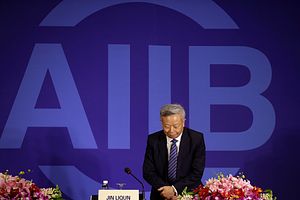The Trump administration’s “America First” foreign policy has marked a reversal of the U.S. global presence and a retreat from multilateralism. One component of this withdrawal has been a substantial reduction in U.S. foreign aid – and other global powers are rising to fill the vacuum.
China is a rising power in all areas: economic, cultural, and political. Once China was an aid recipient itself, receiving official development assistance (ODA) and other official flows (OOF); the former intended for improving development and the latter for commercial purposes. In the past decade, China has rapidly developed its own economy and provided financial assistance to a vast number of developing countries, particularly those in East Asia. According to the AidData website, Asian neighbors Cambodia and Sri Lanka are listed among the top recipients of Chinese ODA while Laos and Sri Lanka are among the top ten recipients of Chinese OOF.
Multilaterally, China started contributing to the International Development Association, the lending arm of the World Bank, in its 15th replenishment round in 2007. China has steadily increased its share of the overall IDA replenishment in each subsequent round, while the United States has reduced its. With Washington pulling back from global engagement, Chinese aid is overtaking U.S. aid and could come to dominate East Asia under the Trump administration’s cuts. In fact, if we define foreign aid as simply ODA, Chinese aid in East Asia is roughly close to the same volume as U.S. aid. Many top recipients of Chinese ODA and OOF, however, are found in Africa or South America, rather than East Asia.
Critics would immediately point out that the U.S. position cannot be easily usurped. First, Chinese aid is not the same as American or even aid from any other Organization for Economic Cooperation and Development (OECD) donor. China is not a member of this “club,” which largely adheres to certain guidelines and reports their aid flows. Data on Chinese aid is largely collated by third-party sources such as AidData, which reveals that Chinese aid has a myriad of objectives. While improving development not always a priority, Chinese aid has served purposes as diverse as improving political ties with Laos, providing political gifts to Mongolia, and giving military aid to Timor-Leste.
Second, Chinese aid has no clear governance structure, but is dispersed through a wide array of government or quasi-government organizations as well as state-owned enterprises.
With all these criticisms in mind, it is questionable if China will truly surpass the United States, even as the latter retreats from the global sphere.
But all these criticisms can of course be fired back at the United States: Washington too uses aid for political purposes and has many government agencies that disburse aid in an uncoordinated manner.
The question still remains: will China ever surpass the United States as the top aid donor in China’s own geographical backyard? The first route to make China top aid donor in East Asia could be an increase in Chinese ODA, if the United States does eventually reduce its aid levels (and this is not guaranteed). A more plausible route would be a more indreict one: utilizing the multilateral institutions that China has created to dominate the East Asian aid sphere.
The first such organization is the Asian Infrastructure Investment Bank (AIIB), formed by China to provide loans for infrastructure projects throughout Asia. A China-dominated financial institution, the AIIB is significant as the United States is not a shareholder of this new lending arm. This has allowed China to push forward its preferred form of development, which is not the free market-oriented, neoliberal type promoted by aid from OECD donors.
The AIIB, while providing finances to only the Asian region, is China’s means of countering U.S. dominance of long-standing multilateral institutions like the World Bank and the IMF. The AIIB does have shareholders from Western countries; nevertheless, China is the largest shareholder and the AIIB is headquartered in Beijing.
A second, related tool that China has is the Belt and Road Initiative or BRI and its Silk Road Fund. The BRI focuses on creating six distinct land and maritime routes across the Eurasian region, aiming to improve infrastructure networks between China and the rest of the world so as to improve economic development. Aid provided in the BRI framework is particularly aimed at countries along these trade routes, such as Myanmar and Indonesia. The BRI, as with the AIIB, has the potential to improve national development across Asia, yet it is again a tool to promote Chinese foreign policy through Chinese finances.
One might point out that the BRI is more about Chinese government and perhaps private investment and not about ODA or OOF, or aid as the OECD defines it. Yet, the countries along the six BRI routes are the same aid recipients China has been donating to for years, especially when it comes to infrastructure projects. Furthermore, the Silk Road Fund, unlike AIIB, does not have shareholders from Western countries, allowing the Chinese government to use it as a tool to dominate the East Asian landscape through financial assistance.
The Trump administration has three more years left in its first term. As China carries on with its aid and financial assistance, along with AIIB lending policies and BRI projects, it may well displace the United States as the top foreign aid provider in the East Asian region — unless the Trump administration responds quickly.
Li Jie Sheng is a research analyst with interests in Southeast Asian political economy, wider global political economy, multilateral organizations, and international development.
































